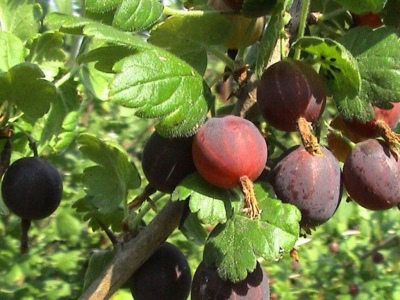
- Authors: K. D. Sergeeva, T. S. Zvyagina, E. Yu. Koveshnikova (All-Russian Research Institute of Horticulture named after I. V. Michurin)
- Appeared when crossing: from free pollination of the Beshipny-3 variety
- Year of approval: 2006
- Growth type: medium-sized
- Description of the bush: sprawling, medium density
- Escapes: growing - of medium thickness, straight or slightly curved, light green, with a weak anthocyanin coloration, not pubescent; lignified - thick, light
- Thorniness: medium
- Thorns: in knots single, medium length and thickness, straight, light-colored
- Sheet: medium to large, light green, shiny, not pubescent, with a smooth or slightly wrinkled surface, delicate, concave
- Spike location: located along the entire length of the shoot, the lower internodes are covered with spines
Gooseberries can be seen in almost every summer cottage. Most summer residents try to grow unpretentious varieties that bring bountiful harvests. These include the Kazachok variety - the pride of Russian selection.
Breeding history
The mid-early variety was bred less than 15 years ago thanks to the work of a group of breeders of the V.N. I. V. Michurina (K. D. Sergeeva, E. Yu. Koveshnikova and T. S. Zvyagina). This species appeared from free pollination of the Beshipny-3 variety. Added to the State Register of Breeding Achievements of the Russian Federation gooseberry in 2006. Berry bushes are allowed for cultivation on the territory of the Central Black Earth Region.
Description of the variety
Cossack is a medium-sized plant that grows up to 100 cm in height. The gooseberry is characterized by strong spreading of the bushes, moderate thickening of pale green leaves with a glossy surface, upright shoots, dark brown buds deviated from the shoot, and medium thorniness. At the time of flowering, the bushes are densely covered with medium-sized flowers of a faded color.
The berry culture is self-fertile (more than 40%), therefore, it practically does not need additional donor varieties planted nearby. Some gardeners recommend planting multiple varieties, which can increase yields.
Characteristics of berries
Gooseberry Kazachok is a medium-fruited species, the berries of which gain weight in the range of 2.9-4 g. At the stage of technical maturity, the berries are evenly covered with a dark purple color (plum), and in a slightly overripe form they are almost black in color. The shape of the fruit is oval or slightly conical. The peel of the berries is moderately dense with a pronounced waxy bloom and practically no edge. On the surface, thin streaks are noticeable, distinguished by a light color.
The fruit has a universal purpose - gooseberries are eaten fresh, processed into jam, marmalade, frozen, widely used in cooking, compotes are boiled. For long-term transportation and long-term keeping quality, it is recommended to create temperature conditions. At zero temperature, berries are stored for up to 30 days, and in a cool place - up to 15 days.
Taste qualities
The berries have a wonderful, balanced taste. The pulp has a delicate, fine-grained and juicy texture. The taste is equally sour and sweet, complemented by a pleasant dessert aroma. The pulp contains more than 12% sugars, ascorbic acid, pectins and catechins.
Ripening and fruiting
Medium early variety. The bush bears fruit in the second year after planting. Berries ripen en masse from late July to mid-August. Maturation occurs gradually.
Yield
The plant's yield indicators are average. Performing all agricultural techniques, 1 bush can give from 2.1 to 4.2 kg of gooseberries per season. Growing on an industrial scale, you can count on 7.014 tons per hectare.
Landing
You can plant a plant both in spring and autumn.Experienced gardeners recommend planting bushes in late September - early October, so that the root system has time to get stronger before the onset of frost. If planted in spring, then you need to have time before the buds swell. The optimal planting material is considered to be two-year-old shoots with three strengthened shoots. The distance between the seedlings should be at least 100 cm.

Growing and care
It is recommended to grow gooseberries on a flat and weed-free area with loose, fertile soil, endowed with an average level of acidity. The seedlings need to be protected from strong winds, and sufficient heat and sun should be provided. Groundwater must run far from the root system of plants, otherwise moisture stagnation can negatively affect development.
The berry bush can be propagated by the following methods - vertical and horizontal layering, combined cuttings, dividing the mother bush and arcuate layering.
Comprehensive care of berry bushes consists of a chain of measures: watering, fertilizing on schedule, loosening the soil, rejuvenating and preventive pruning of branches, installing support for bushes, preparing for winter (mulching with sawdust or humus), as well as protection from viruses and insects ...
To prevent the berries from cracking during storage, watering the bush must be stopped a few weeks before harvesting.



Disease and pest resistance
The plant has an average immune defense against many diseases and viruses. The cultivar is not exposed to American powdery mildew and spherotec. Spraying with insecticides and fungicides will help protect against other diseases and invasions of harmful insects. The most dangerous insects for gooseberries are gall midges, aphids, spider mites and sawflies.

In order for the gooseberry to produce a good harvest, it is necessary to devote time to disease prevention.
Resistance to adverse climatic conditions
The gooseberry Kazachok is characterized by winter hardiness, the ability to tolerate droughts, heat, temperature changes. Excess moisture and drafts can negatively affect the yield.




































































